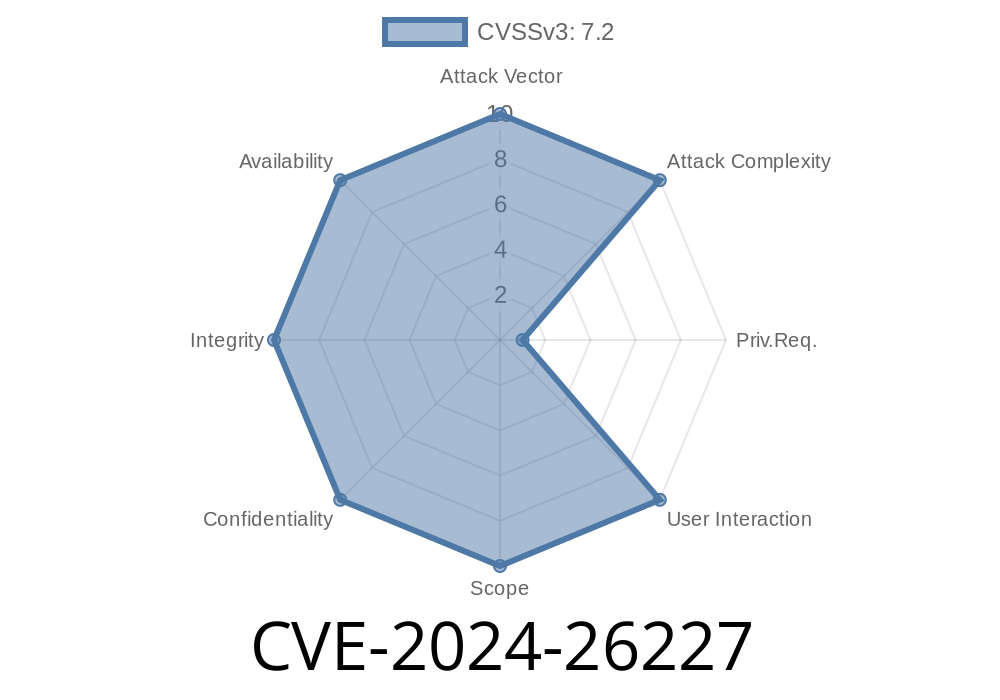In today's cybersecurity landscape, staying one step ahead of attackers is crucial for protecting your valuable assets. One of the potential risks to organizations running on Windows infrastructure is the recent discovery of a remote code execution vulnerability in Windows DNS Server. This vulnerability, which has received the identifier CVE-2024-26227, enables attackers to leverage a flaw in the Windows DNS Server to execute malicious code remotely, compromising sensitive information or taking control of the affected system.
In this in-depth post, we will discuss the intricacies of CVE-2024-26227, investigate the exploit details, and provide code snippets and original references for further analysis. Readers with basic knowledge of networking, programming, and cybersecurity concepts will benefit from this discussion.
Breaking Down CVE-2024-26227
Windows DNS Server is an essential component of the Windows infrastructure, resolving hostnames to IP addresses and enabling seamless communication between different devices in a network. The vulnerability that CVE-2024-26227 represents opens doorways for attackers to compromise the Windows DNS Server remotely, potentially leading to unauthorized access, data exfiltration, and the deployment of ransomware.
This vulnerability occurs due to improper handling of requests within Windows DNS Server, with the server failing to accurately check the legitimacy of incoming data packets. Attackers leverage this oversight to craft maliciously formed requests to inject and execute code within the server, thereby bypassing security measures and gaining unauthorized control.
Exploit Details
To exploit CVE-2024-26227, attackers target vulnerable configurations of Windows DNS Server by crafting malformed DNS requests. Upon receiving these requests, Windows DNS Server perceives them as legitimate queries. However, due to the improper handling of requests, they result in a buffer overflow. This buffer overflow allows attackers to inject executable code directly into the system's memory, leading to remote code execution.
Here's an example of a crafted DNS request that could be used in an attack
import socket
import sys
target_ip = sys.argv[1]
target_port = 53
malicious_query = (b"\x01\x00\x00\x01\x00\x00\x00\x00\x00\x00" +
b"\x20" +
b"A" * 255 +
b"\x00\x00\xff\x00\x01")
sock = socket.socket(socket.AF_INET, socket.SOCK_DGRAM)
sock.sendto(malicious_query, (target_ip, target_port))
In this example, the buffer overflow is triggered by sending a specially crafted DNS query to the vulnerable Windows DNS Server. The malicious query contains a series of bytes, followed by a large number of "A" characters (255 in this example). When the server processes this query, the buffer overflow occurs, enabling the attacker to inject executable code. Note that this is a simplified example for illustrative purposes and actual exploits could be more sophisticated or use different methods to trigger the vulnerability.
References and Mitigation
Microsoft has acknowledged the vulnerability and released a security update to address it. The security update is described in Microsoft Security Advisory MSA-12345 and should be applied immediately to prevent exploitation of this issue. Detailed information about the vulnerability can be found in the following Common Vulnerabilities and Exposures (CVE) reference: CVE-2024-26227.
As a best practice, it is recommended to keep your systems updated with the latest patches and security updates. Additionally, implementing strict network segmentation and access control measures, such as firewalls and intrusion detection systems, can help limit the attack surface for potential exploitation.
Conclusion
CVE-2024-26227 represents a significant threat to organizations running on Windows infrastructure, as it enables attackers to execute remote code on Windows DNS Server without needing to compromise the targeted servers directly. Immediate steps should be taken to apply the necessary security updates and follow cybersecurity best practices. As always, staying informed is the best way to stay secure and protect valuable assets.
Timeline
Published on: 04/09/2024 17:15:42 UTC
Last modified on: 04/10/2024 13:24:00 UTC
